
| Water Science | ||

|
|
|||||||||
|
|
||||||||||||||||||||||||||||||||||||||||||||||||||||||||||||||||||||||||||||||||||||||||||
|
United States |
Office of Water |
EPA-823-N-99-003 Number 23 Spring 1999 |
|
|
|
|||
|
In
this Regional
Activities... Contaminated Sediment Web Pages
CS News is produced by the EPA Office of Science and Technology (OST) to exchange information on contaminated sediments and to increase communication among interested parties. To obtain copies of this report or to contribute information, contact Jane Marshall Farris, EPA OST, mail code 4305, 401 M Street S.W., Washington, DC 20460 at (202) 260-8897. To be added to the mailing list or to make changes to your address, please fax your request to Jane Marshall Farris at (202) 260-9830. |
EPA Great Lakes National Program Office
PCB-Contaminated Sediments Successfully Removed from Site in Fox River
The Wisconsin Department of Natural Resources (WDNR) successfully completed a contaminated sediment remediation demonstration dredging project at the Fox River Deposit “N” in Kimberly, Wisconsin.
The project was the result of a partnership between the WDNR, the Fox River Coalition (a coalition of local municipalities, industries, and environmental groups), and the U.S. Environmental Protection Agency’s Great Lakes National Program Office (GLNPO). The project was partially funded by a $500,000 grant from GLNPO to the WDNR. Total project costs were approximately $5,000,000. The project was initiated to remove polychlorinated biphenyl (PCB) laden sediments from the aquatic system and to restore the health of a portion of the Fox River. Another major goal of the project was to demonstrate that dredging of contaminated sediment could be performed on the Fox River in an environmentally sensitive manner.
Deposit N and the Fox River

Deposit “N”is one of 34 PCB-sediment deposits that have been
identified along the Fox River and contained one of the highest average
PCB concentrations found in the river—averaging approximately 45 parts
per million (ppm) with a maximum concentration of approximately 400 ppm.
In total, approximately 7,000 cubic yards of contaminated sediments were
removed from Deposit N between November 23, 1998 and December 31, 1998
when severe weather halted dredging operations.
Deposit N is part of the Fox River and the Lower Green Bay Area of Concern. The Lower Fox River extends 39 miles from Lake Winnebago to the mouth of the river where it enters Green Bay and Lake Michigan. The presence of PCBs has long been a source of concern in the Fox River since the 1950s, 1960s and 1970s when large volumes of PCBs were discharged to the river as part of the manufacturing process for carbonless paper, paper de-inking, and paper recycling. The Fox River delivers an estimated 600 pounds of PCBs to Lake Michigan each year.
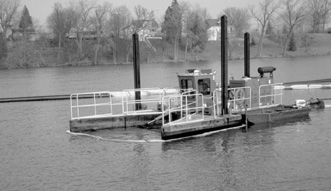
Clean Up
Prior to remediation, a comprehensive assessment and characterization program delineated the boundaries of the PCB-contaminated sediment. Total surface area of the deposit was approximately three acres. The deposit was then fully enclosed with a high density polyethylene geomembrane silt curtain to prevent offsite migration of sediments during dredging. The contaminated sediments were hydraulically dredged and piped across the river to a sediment processing and dewatering facility where they were treated and sampled before being trucked off-site for final disposal. Dewatered sediments with PCB concentrations greater than 50 ppm were shipped to a Michigan landfill licensed under the Toxic Substances Control Act. Sediments with a final PCB concentration of less than 50 ppm were disposed of in a local county landfill. Suspended solids samples were collected every 15 minutes during the dredging operation to insure that contaminated sediments were not being released from the dredging site.
Post-project monitoring is currently taking place to determine residual sediment PCB concentrations and to calculate the mass of PCBs and volume of sediments removed.
Public Outreach Efforts
As part of this project the WDNR launched an aggressive public outreach program that included several public meetings and information sessions, a viewing platform for observing the dredging project and a public open house that included a tour of the dredging operations and the sediment processing facility. This effort has led to a more informed public and improved public support of sediment remediation on the Fox River.
For More Information
Additional information on this project is available from Scott Cieniawski, Sediment Assessment and Remediation Team, Great Lakes National Program Office, at (312) 353-9184; E-mail: cieniawski.scott@epamail.epa.gov.
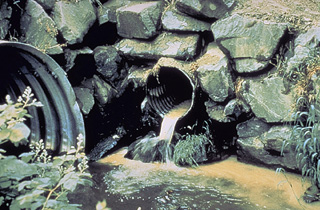
| Headquarters
Activities |
Status of EPA-OST Sediment Documents
Editor’s Note: EPA’s Office of Science and Technology within the Office of Water and EPA Labs within the Office of Research and Development continue to develop documents about sediment guidelines, management, implementation guidance, assessment, and models. Some documents are in planning stages, while others are very near completion. The status and description of these documents are provided in the following table.
| Document Title |
Description
|
Status
|
|
| 1 | Implementation Framework for Use of Equilibruim Partitioning Sediment Guidelines | Guidance on the use of equilibrium partitioning sediment guidelines (ESGs) in water quality standards, TMDL development, NPDES permitting, SUPERFUND, and RCRA programs. Contacts: Jane Farris at 202-260-8897, or Cindy Roberts at 202-260-2787. |
Expected Federal Register announcement of availability of draft implementation framework, Fall 1999. |
| 2 | Bioaccumulation Testing and Interpretation for the Purpose of Sediment Quality Assessment: Status and Needs | Provides background information and reports on the status of bioaccumulation testing and interpretation in various EPA and other federal agency programs for the purpose of sediment quality assessment. Contact: Tom Armitage at 202-260-5388. | Final scheduled for Summer 1999. |
| 3 | Methods for Measuring the Toxicity and Bioaccumulation of Sediment-associated Contaminants with Freshwater Invertebrates | This is a second edition of the 1994 freshwater standard sediment test methods manual that includes updates of the two short-term standard freshwater sediment toxicity test methods (Chironomus tentans and Hyalella azteca) and the standard bioaccumulation method (Lumbriculus variegatus) published in 1994 and two new long-term sediment toxicity test methods for Chironomus tentans and Hyalella azteca. Contact: Leanne Stahl at 202-260-7055. | Final scheduled for June 1999. |
| 4 | Public Outreach: Contaminated Sediment Pamphlet and Poster | Pamphlet and poster will educate the public, including citizens groups and high school students on the definition and extent of contaminated sediment, sources of contamination, remediation and pollution prevention solutions, and what the citizen can do to protect sediment. Contact: Jane Farris at 202-260-8897. | Final pamphlet and poster scheduled for publication in the fall of 1999. |
| 5 | Methods for Assessing the Chronic Toxicity of Marine and Estuarine Sediment-associated Contaminants with the Amphipod Leptocheirus plumulosus | This will be a joint EPA/U.S. Army Corps of Engineers publication that contains a standard 28-day marine and estuarine sediment toxicity test method using Leptocheirus plumulosus with endpoints for survival, growth, and reproduction. Contact: Leanne Stahl at 202-260-7055. | Final scheduled for September 1999. |
| 6 | Methods for Collection, Storage, and Manipulation of Sediments for Chemical and Toxicological Analysis | This guidance manual covers the following topics: (1) collecting, handling, and transporting field sediments; (2) manipulating sediments in the laboratory for chemical analysis and toxicological testing; and (3) preparing formulated sediments for toxicological testing. Contact: Leanne Stahl at 202-260-7055. | Final scheduled for December 1999. |
| 7 | Technical Document: Models for Sediment Quality-Based NPDES Permitting | Describes the technical aspects of applying existing hydrodynamic/water quality models for the development of sediment quality-based NPDES permits. The document discusses underlying theory, model classification, and applications to different environmental settings. Contact: Bill Tate at 202-260-7052. | Draft scheduled for FY99. |
| 8 | The Incidence and Severity of Contamination in Surface Waters of the United States, Volumes 1-4 | Volume 1: Draft National Sediment Quality Survey; Volume 2: Data Summary for Areas of Probale Concern (APCs); Volume 3: Sediment Contaminant Point Source Inventory; and Volume 4: Sediment Contaminant Nonpoint Source Inventory. Contact: Jim Keating at 202-260-3845. | Volumes 1-3 were published in September 1997. Volume 4 is under development. |
| 9 | Evaluation of Dredged Material Proposed for Discharge to Inland Waters of the United States—Testing Manual | Provides a national testing framework which comprises one element of an overall decision-making process for determining whether dredged material can be discharged into CWA Section 404 waters. Joint EPA-OST and U.S. Army Corps of Engineers Document. Contact: Tom Armitage at 202-260-5388. | Published February 1998. EPA-823-B-98-004 |
| 10 | EPA's Contaminated Sediment Management Strategy | Describes EPA's understanding of the extent and severity of sediment contamination. Contact: Jane Farris at 202-260-8897. | Published April 1998. EPA-823-R-98-001 |
| 11 | Technical Basis for Deriving Sediment Guidelines for Nonionic Organic Contaminants for the Protection of Benthic Organisms by Using Equilibrium Partitioning (TBD) | See article below. Contact Heidi Bell at 202-260-5464. | Publication scheduled for Fall 1999 |
| 12 | Methods for Deriving Site-specific Equilibrium Partitioning Sediment Guidelines for the Protection of Benthic Organisms (SS) | See article below. Contact Heidi Bell at 202-260-5464. | Publication scheduled for Fall 1999 |
| 13 | Equilibrium Partitioning Sediment Guidelines for the Protection of Benthic Organisms: Dieldrin (Dieldrin ESG) | See article below. Contact Heidi Bell at 202-260-5464. | Publication scheduled for Fall 1999 |
| 14 | Equilibrium Partitioning Sediment Guidelines for the Protection of Benthic Organisms: Endrin (Endrin ESG) | See article below. Contact Heidi Bell at 202-260-5464. | Publication scheduled for Fall 1999 |
| 15 | Equilibrium Partitioning Sediment Guidelines for the Protection of Benthic Organisms: Acenaphthene | This document will not be finalized pending publication of a PAH Mixtures Guidance Document—refer to article below. | Proposed in 1994. |
| 16 | Equilibrium Partitioning Sediment Guidelines for the Protection of Benthic Organisms: Fluoranthene | This document will not be finalized pending publication of a PAH Mixtures Guidance Document—refer to article below. | Proposed in 1994. |
| 17 | Equilibrium Partitioning Sediment Guidelines for the Protection of Benthic Organisms: Phenanthrene | This document will not be finalized pending publication of a PAH Mixtures Guidance Document—refer to article below. | Proposed in 1994. |
Status on Sediment Guidelines Documents
SQCs to ESGs
EPA originally proposed chemical-specific sediment quality criteria (SQC) for use in assessing contaminated sediments in 1995. Since that time, EPA has made significant progress in several areas of sediment research and assessment guidance. Most notably, negotiations over the last two years between EPA and the U.S. Army Corps of Engineers (USACE) have successfully resulted in agreement between the two agencies on the intended application and implementation of EPA sediment guidelines. The application and implementation will be described in the document Implementation Framework for Use of Equilibrium Partitioning Sediment Guidelines. In keeping with this agreement, as well as to provide greater flexibility to states, tribes and the regulated community, EPA will no longer be issuing “SQC” but rather equilibrium partitioning sediment guidelines or ESGs. It is anticipated that this “guidance” (i.e., ESGs), along with whole sediment bioassays, will be incorporated by states and tribes into their narrative standards in order to protect and assess contaminated sediments. The term “ESGs” will be applied to all forthcoming chemical-specific sediment guidance documents issued by EPA.
Public Comment Received
The Agency requested and received public comment in 1994 for the sediment guidance documents listed as items 11-17 in the previous table.
EPA has responded to public comment on these documents and intends to publish the responses in the Federal Register when the Implementation Framework for Use of Equilibrium Partitioning Sediment Guidelines is finalized. At this time, we are completing updates and revisions to four documents described in the previous table (Nos. 11-14). We anticipate publishing these four documents as final in Fall 1999.
Guidance on Mixtures of PAHs
Additional research has been conducted on the toxicity and bioavailability of polycyclic aromatic hydrocarbons (PAHs) since proposing the individual PAH guidance documents for acenaphthene, fluoranthene and phenanthrene. Since PAHs occur most often as mixtures in sediments, rather than as single chemicals, it is more environmentally relevant to provide guidance which addresses mixtures of PAHs. In addition, the narcosis mode of toxicity of PAHs is additive. In other words, the toxicity is due to the sum of the individual PAH chemicals (ΣPAH). Thus, it is most environmentally relevant and ecologically protective to provide guidance which addresses mixtures of PAHs. The ΣPAH model developed by EPA’s Office of Research and Development (ORD) Corvallis laboratory provides a method to accurately address the toxicity and bioavailability of mixtures of PAHs in sediments. The ΣPAH model and proposed approach were reviewed by the Science Advisory Board (SAB) in May 1997 and received a favorable response. EPA scientists have performed additional research and data analysis in order to strengthen the scientific foundation and to respond to the SAB comments. Present efforts include making revisions to the document to include these updates and reflect the current state of the science. It is anticipated that a final draft of the PAH Mixtures ESG will be available in the summer of 1999. At that time, EPA will determine if additional research is required or if the document is ready to go final. Updates on the status of the PAH Mixtures ESG will be provided in the near future.
Guidance on Mixtures of Metals
EPA has also developed a sediment guidance document to address mixtures
of metals in sediments. This document was reviewed by the SAB in 1995
and recommendations from the review have been addressed, responded to,
and additional research has been performed where necessary. At the present
time, the Metals Mixtures ESG addresses the toxicity of six metals (cadmium,
copper, lead, nickel, silver and zinc). EPA is currently incorporating
chromium toxicity information and a proposed means to predict toxicity
using the fraction organic carbon
(f![]() ) into the
document. The Metals Mixtures ESG was presented to the SAB panel in April
1999 during a review of the Integrated Approach to Assessing the Toxicity
and Bioavailability of Metals in Surface Waters and Sediments (see
Announcement Section for more detail). Following this SAB Review, any
necessary comments, revisions, or additional work shall be incorporated
into the document. A finalized Metals Mixtures ESG document should be
available in Fall 1999.
) into the
document. The Metals Mixtures ESG was presented to the SAB panel in April
1999 during a review of the Integrated Approach to Assessing the Toxicity
and Bioavailability of Metals in Surface Waters and Sediments (see
Announcement Section for more detail). Following this SAB Review, any
necessary comments, revisions, or additional work shall be incorporated
into the document. A finalized Metals Mixtures ESG document should be
available in Fall 1999.
For More Information
Any questions or comments regarding these sediment guidance documents should be addressed to the U.S. EPA, Heidi Bell (202) 260-5464.
Regional
Activities  |
Sediment Regional
Priority Removal Action Initiated on Pine River to Address DDT Contamination
A Superfund time-critical removal action began late in the summer of 1998 to address the 1,1,1-trichloro-2,2-bis(chlorophenyl)ethane (DDT) contamination in Pine River sediments at the Velsicol Chemical site in St. Louis, Michigan. Pine River sediments contain total DDT concentrations as high as 32,600 parts per million (ppm) and are also contaminated with polybrominated biphenyl (PBB). The state of Michigan issued a “no consumption” advisory for all species of fish in the Pine River because DDT concentrations exceed health guidelines. Carp (1997 data) have DDT concentrations up to about 90 ppm and average approximately 35 ppm. Smallmouth bass (1997 data) have a maximum concentration of approximately 21 ppm and an average concentration of approximately 11.4 ppm total DDT. This Superfund action will address the removal of approximately 21,500 cubic yards (cy) of the most highly contaminated sediment, which is that exceeding 3,000 ppm total DDT. Approximately 430,400 pounds of DDT will be removed.
Schedule
Construction of the infrastructure was completed in the Fall of 1998; removal of the sediment will take place in the Spring of 1999. Once excavation begins, it is expected to take 120 on-site working days to complete the cleanup. The removal action includes the installation of coffer dams, “dry” excavation of the DDT-contaminated sediment, dewatering and treatment of the water prior to discharge to the St. Louis impoundment (Pine River), and disposal of the sediment in an approved off-site landfill. The cost is estimated at $6 million, and will be paid for out of USEPA’s Removal Program.
This action begins as a Proposed Plan to address the remainder of the DDT-contaminated sediment and was released for public comment. The proposed action would clean up the Pine River sediment down to 5 ppm total DDT and remove an additional 260,000 cy of sediment, and 4,600 pounds of DDT. The proposed action involves the placement of temporary coffer dams, “dry” excavation of the contaminated sediment, dewatering and treatment of the water, and off-site disposal of the sediment. This USEPA-funded action is estimated at $16.9 million.
Support for this project is being provided by the FIELDS group in the USEPA Region 5 Water Division. Additional information regarding sediment and fish contamination, and the risk assessment is available via the FIELDS website at: www.epa.gov/region5fields/. For more information, contact Sam Borries at (312) 353-2886 or Beth Reiner at (312) 353-6576.
Ansul Fire Protection 8th Street Slip—Action to Address Arsenic Contamination in Menominee River, Wisconsin
An Interim Measures Agreement was signed by USEPA and Ansul Fire Protection on September 28, 1998 to remove arsenic-contaminated sediment from the 8th Street Slip and conduct additional investigations at the Menominee River Turning Basin. The Ansul facility is located on the Menominee River in Marinette, Wisconsin.
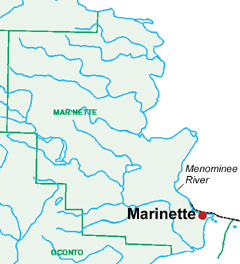 Ansul completed on-site construction of the groundwater barrier system to prevent
the continued migration of arsenic-contaminated groundwater into the Menominee
River from the Ansul facility. The barrier system encompasses the most
highly contaminated areas on-site. The groundwater contains arsenic at
concentrations up to 8,530 ppm and exceeds the federal maximum contaminant
level for drinking water of 0.05 ppm. Ansul will commence dredging of
arsenic-contaminated soft sediment from the 8th Street Slip by June 15,
1999—dredging should be completed by the end of 1999. Sediment in the
Slip are contaminated with arsenic up to 22,000 ppm.
Ansul completed on-site construction of the groundwater barrier system to prevent
the continued migration of arsenic-contaminated groundwater into the Menominee
River from the Ansul facility. The barrier system encompasses the most
highly contaminated areas on-site. The groundwater contains arsenic at
concentrations up to 8,530 ppm and exceeds the federal maximum contaminant
level for drinking water of 0.05 ppm. Ansul will commence dredging of
arsenic-contaminated soft sediment from the 8th Street Slip by June 15,
1999—dredging should be completed by the end of 1999. Sediment in the
Slip are contaminated with arsenic up to 22,000 ppm.
At the Menominee River Turning Basin, also addressed under the Agreement, Ansul will conduct additional investigations of the extent and severity of arsenic contamination in basin sediment. A work plan was due to USEPA by March 15, 1999. Additional cleanup measures to address the Turning Basin will be developed. Future updates will provide additional information as it becomes available. For more information, contact Robert Smith at (312) 886-7568 or Lisa Capron at (312) 886-0878.
Dredging Team Sponsors Workshop
The Great Lakes Regional Dredging Team sponsored a Beneficial Uses of Dredged Material Workshop on September 15-16, 1998 in Toledo, Ohio in conjunction with the Great Lakes Dredging Team meeting. Beneficial use is becoming the answer to the question of what to do with dredged material from our ports and waterways that can no longer be disposed of due to open water disposal restrictions or lack of disposal space. Approximately 25 percent of dredged material is currently used for beneficial purposes in the Great Lakes. Such uses include the restoration of habitat, shoreline protection, and manufacture of topsoil.
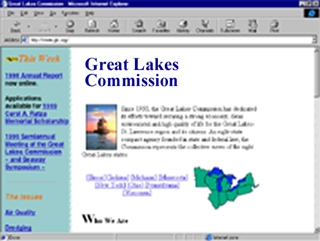 The workshop
explored the various beneficial uses, including those currently being
implemented and those still at the pilot study stage. Beneficial uses
include habitat building opportunities (e.g., Pointe Mouillee Confined
Disposal Facility and State Game Area); upland and commercial uses (e.g.,
manufactured soil from Toledo Harbor); and shoreline protection and restoration
uses (e.g., Illinois Sand Management Task Force). The workshop focused
on each of these uses, providing case studies and panel discussions. The
final session included regulatory issues and obstacles to beneficial use.
The major obstacles identified included regulatory inflexibility, lack
of guidance for beneficial use applications, and lack of public involvement.
Recommendations to overcome these obstacles included developing guidance
for beneficial uses, public outreach and education, and incorporating
dredged material management into the bigger arena of watershed planning.
These recommendations were taken to the Great Lakes Dredging Team for
further consideration and action. For more information, contact Scott
Cieniawski at (312) 353-9184 or Bonnie Eleder at (312) 886-4885.
The workshop
explored the various beneficial uses, including those currently being
implemented and those still at the pilot study stage. Beneficial uses
include habitat building opportunities (e.g., Pointe Mouillee Confined
Disposal Facility and State Game Area); upland and commercial uses (e.g.,
manufactured soil from Toledo Harbor); and shoreline protection and restoration
uses (e.g., Illinois Sand Management Task Force). The workshop focused
on each of these uses, providing case studies and panel discussions. The
final session included regulatory issues and obstacles to beneficial use.
The major obstacles identified included regulatory inflexibility, lack
of guidance for beneficial use applications, and lack of public involvement.
Recommendations to overcome these obstacles included developing guidance
for beneficial uses, public outreach and education, and incorporating
dredged material management into the bigger arena of watershed planning.
These recommendations were taken to the Great Lakes Dredging Team for
further consideration and action. For more information, contact Scott
Cieniawski at (312) 353-9184 or Bonnie Eleder at (312) 886-4885.
|
Highlights from the Great Lakes Regional Dredging Team Meeting
Members of the Great Lakes Regional Dredging Team (GLDT) met September 16-17, 1998 in Toledo, Ohio. Most of the meeting focused on the white paper, Decision Making Process for Dredged Material Management. The paper is completed and provides an overview of the dredged material management planning process, regulatory requirements, and roles and responsibilities of involved agencies and other parties. The purpose of the paper is to address the questions, issues and uncertainties surrounding the dredged material planning process and develop recommendations for improvement. As a result, there is a better understanding of the process and roles and responsibilities. A number of recommendations were made to address the issues and improve the process. Three key recommendations are 1) to integrate the dredged material planning process into local watershed planning; 2) focus on developing partnerships with NRCS, state conservation districts, and others to address nonpoint source pollution and soil erosion control; 3) work with USEPA Beneficial Use Workgroup to develop guidelines for different regional beneficial use applications, and conduct a pilot; and 4) expand public outreach and education regarding the process. Two new workgroups were formed for the first two recommendations. The Public Outreach
Workgroup has completed a number of fact sheets (Great Lakes
Dredging Team, Confined Disposal Facilities). In addition, they
have a draft of a dredging brochure and are planning a dredging
video which will focus on both navigational and remedial dredging
projects. This information and more may be found on the workgroup's
website at http://www.glc.org/projects/. The GLDT Charter established a 2-year run for the co-chairs, of whom would be comprised one each from a federal and state agency. The new co-chairs were announced and are Bonnie Eleder from USEPA and Wayne Warren from Ohio Department of Natural Resources. For more information, contact Bonnie Eleder at (312) 886-4885 or Marc Tuchman at (312) 353-1369. |
Great Lakes
Sediment Guidance Document on
Capping and Natural Recovery
U.S. EPA-Region 5, the U.S. Geological Survey (USGS) and the U.S. Army Corps of Engineers are preparing a guidance document for the capping and natural recovery of contaminated sediments. Capping is the placement of an engineered and artificially placed layer of material over an in situ deposit of contaminated sediment, while natural recovery relies upon ongoing processes of natural sedimentation for cover placement. The goal of both capping and natural recovery is to provide a level of physical and chemical isolation for the sediment-bound contaminants sufficient to protect the proximal surface-water environment and the indigenous biota. Focusing upon the hydrogeologic aspects of capping and natural recovery at contaminated sediment sites, the document will specifically address the following issues:
Site Characterization: The types of hydrogeologic site characterization information needed to characterize a site and predict cover performance where capping or natural recovery is proposed will be defined. Methods for the collection of this information will also be discussed.
Cover Performance Prediction: Sediment cover parameters and hydrogeologic site characteristics will be used to predict the effectiveness of the cover as a barrier to the transport of the underlying sediment-bound contaminants. Performance predictions are commonly generated through the use of a one-dimensional mass transport equation called the advection-dispersion equation. The advection-dispersion equation addresses transport caused by concentration differences (diffusion) and ground water flow (advection). In addition, the advection-dispersion equation can be amended to account for such factors as contaminant sorption and decay.
Performance Prediction Uncertainty: Through the use of error analysis procedures, the uncertainties associated with the parameter values used to predict cover performance will be used to estimate the potential uncertainty in the cover-performance predictions.
Cover Performance Monitoring: Methods to access various aspects of cover performance will be outlined and discussed.
The final document is scheduled to be published by the USGS by the end of FY 99. USGS participation in the project is being financed through a Great Lakes National Program Office grant. For more information, contact David Petrovski at (312) 886-0997.
EPA/Oklahoma Assess Sediment Quality in Lake Arcadia, Oklahoma
In March 1997 EPA Region 6 assisted the Oklahoma Water Resources Board with an assessment of sediment quality of Arcadia Lake. This lake is located in an urban watershed north of Oklahoma City, with two primary tributaries, Spring Creek and Deep Fork. Available historical data indicated potential sediment quality problems in several portions of the lake. As part of an EPA-funded Clean Lakes Diagnostic/Feasibility Study, the state sought to determine the degree of sediment contamination within the lake through sediment chemical analyses and toxicity testing.
Parameters
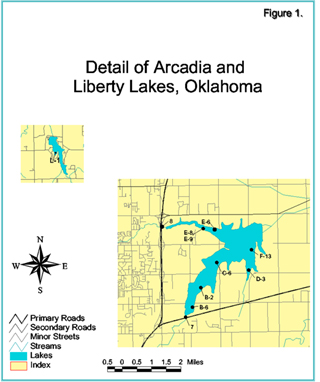
Researchers collected and composited three samples per site (10 sites total) using an Ekman grab. Additional samples were collected from the reference site, Liberty Lake. The EPA Houston Laboratory analyzed for TOC, grain size, and priority pollutants—including volatiles, semi-volatiles, PCBs, pesticides and heavy metals. Sediment toxicity tests were also conducted for five sites at the EPA lab and included elutriate testing using 7-day chronic Ceriodaphnia and fathead minnow embryo/larval tests. Elutriates were prepared by diluting one part sediment to four parts water, shaking for 24 hours, and siphoning off the overlying water. These tests were used as a cost- effective alternative to standard bulk sediment tests.
Results
Available screening levels were used to evaluate the chemical data including NOAA Effects Range-Low (ER-L) and Effects Range-Median (ER-M) values, Ontario’s Lowest and Severe Effects Levels (LEL, SEL), Apparent Effects Thresholds Low and High (AET-L, AET-H), EPA Equilibrium Sediment Quidelines (ESGs). Sediment TOC ranged from 0.17 percent to 2.88 percent. ER-M and SEL values were not exceeded for any parameters, indicating that the sediments were not severely contaminated. ESGs were also not exceeded, although values were available for only four of the contaminants detected. Table 1 (below) summarizes the analytical results. No significant chronic toxicity was observed to Ceriodaphnia and fathead minnows for the five stations tested.
Conclusion
The data indicated significant, but relatively low levels of sediment contamination. There were elevated levels of PAHs in lake sector B. Metals were most elevated in sector C, as was Bis(2-ethylhexyl) phthalate. These sectors comprise the upper and lower Deep Fork arm of the lake, respectively. Cadmium was found throughout (except the two tributary sites), including the Liberty Lake reference site. While additional toxicity tests would aid in determining sediment quality the existing data indicate that pollutants, in combination, are not present at toxic levels.
The project demonstrated that sediment contaminant levels are a good indicator of nonpoint pollution in this urban watershed. The data indicate that nonpoint source controls to reduce pollutant loads (metals, PAHs) would benefit sediment quality and reduce risks to benthic organisms. Concentrating on watershed protection efforts in the Deep Fork portion of the watershed would be most appropriate to enhance and protect sediment quality in Arcadia Lake. Contact Philip Crocker, EPA Region 6, Watershed Management Section if you would like to request a copy of the summary report (214-665-6644; crocker.philip@epa.gov).
Sediment Management Training
 An
intermediate level sediment management training course was provided to
Region 10 on February 18 and 25. The participants in this course came
from EPA's Aquatic Resources Unit, Office of Environmental Cleanup, Office
of Environmental Assessment, Office of Water, and Office of Waste and
Chemicals Management. In addition, one-third of the trainees were from
outside EPA, including representatives from several state and federal
agencies and one tribe. The mix of participants shows that the issues
that relate to contaminated sediments and sediment management are not
narrowly confined, but truly cut across programs and agencies.
An
intermediate level sediment management training course was provided to
Region 10 on February 18 and 25. The participants in this course came
from EPA's Aquatic Resources Unit, Office of Environmental Cleanup, Office
of Environmental Assessment, Office of Water, and Office of Waste and
Chemicals Management. In addition, one-third of the trainees were from
outside EPA, including representatives from several state and federal
agencies and one tribe. The mix of participants shows that the issues
that relate to contaminated sediments and sediment management are not
narrowly confined, but truly cut across programs and agencies.
Course topics included: regulatory overview; sources, fate/transport, and environmental/health effects of contaminants of concern; basic study design for chemical and biological testing; including sampling plans, sampling protocols, chemical analyses and biological testing and quality assurance. Other topics included bioaccumulation, source control, natural recovery, data needs for feasibility studies, how to interpret chemistry data, ecological risk assessment using bioassay and benthic data, human health and ecological risk assessment using bioaccumulation data, determining site boundaries and selecting cleanup standards, and remediation strategies.
This training provided a comprehensive overview of the major tools and the interpretive techniques which are used to properly evaluate sediments. Participant response to the training was unanimously positive, with particular appreciation of the use of local case studies to illustrate course material. For more information, contact Anne Robinson at (206) 553-6219.
Sediment Management Annual Review Meeting
The eleventh annual Sediment Management Annual Review Meeting (SMARM)
was held May 5-6, 1999, at the Washington State Department of Ecology
(Ecology) in Lacey, Washington. This public meeting has historically dealt
specifically with issues in Washington, mainly related to the Dredged
Material Management Program (DMMP), and the Washington State Sediment
Management Standards (SMS). With the release and implementation of the
Dredged Material Evaluation Framework for the Lower Columbia River Management
Area, based on the DMMP, the intent was to include Oregon representatives
and thus broaden the scope of the meeting to be more regional. The framework
is available on the Corps of Engineers, Portland District homepage at:
http://www.nwp.usace.army.mil/. ![]()
A number of dredged material management program issue papers and agency
clarifications were presented to the public at the meeting. See the Corps
of Engineers Seattle District website: http://www.nws.usace.army.mil/. ![]() Presentations included an update on the status of the Multi-user Disposal
Site (MUDS). The draft environmental impact statement (EIS) for MUDS was
released February 1999.
Presentations included an update on the status of the Multi-user Disposal
Site (MUDS). The draft environmental impact statement (EIS) for MUDS was
released February 1999.
Updates on the Bellingham Bay Pilot Project as well as on the Bioaccumulation Workgroup were also presented. Of particular interest this year is an update by Ecology on the EIS for the SMS draft rule revision, which may include human health guidelines. For more information, contact Justine Barton at (206) 553-4974 or John Malek at (206) 553-1286.
Draft EIS for Columbia River Channel Improvements
The draft Integrated Feasibility Report for Channel Improvements and Environmental Impact Statement (DEIS), Columbia & Lower Willamette River Federal Navigation Channel, which includes the Columbia River deepening project, was released to the public in October, 1998, by the Corps of Engineers, Portland District. The stated purposes of this effort are to improve deep-draft transport of goods in the navigation channel, and to provide ecosystem restoration of fish and wildlife habitats. One of the important aspects of this project is the documentation supporting designation of both river and ocean disposal sites for long term use. These sites will be used for disposal of dredged material from the mouth of the Columbia River (a separate federal project), and construction/maintenance of the proposed channel improvements. An important feature of this project is its disposal site management orientation. Although not required by §404 of the Clean Water Act, management plans will be developed for each river and upland disposal site. Management objectives and monitoring plans will be integral to each plan. Comments on the draft were due by February 5. EPA is a cooperating agency on this EIS. For more information, contact John Malek at (206) 553-1286.
Portland Harbor Project
The Portland Harbor Project focuses on approximately a 6-mile stretch of the lower Willamette River in the state of Oregon. Much of the upland in this area is heavily industrialized and marine traffic on the Willamette River is intensive. Past and present industrial operations have been identified as potential contamination sources. A site assessment including sampling, conducted by Region 10 Superfund in cooperation with the Oregon Department of Environmental Quality (ODEQ) showed elevated levels of compounds such as DDT, PCB, heavy metals and PAHs.
This sampling data will be evaluated by an EPA panel to see whether the site should be proposed for the National Priorities List (NPL) more commonly known as a Superfund site. ODEQ will participate as part of the evaluation team. The team may choose to examine alternatives to NPL listing, such as deferring to the state of Oregon to conduct the investigation instead of EPA. While it is likely that the Portland Harbor Project will rank as a potential NPL site, ODEQ, with the support of the Port of Portland and other local industries, has expressed interest in taking the lead on conducting future studies and cleanups in lieu of formal NPL listing. Recently, ODEQ finalized a funding agreement with the group of industries and others in the Portland Harbor Project study area to create a plan for investigating and remediating area sediments. Development of that plan is already underway. For more information, contact John Malek at (206) 553-1286.
Puget Sound Confined Disposal Study
The programmatic Environmental Impact Statement (EIS) for the Puget Sound Confined Disposal Study was released to the public in February 1999. This document provides initial environmental review and cost analysis for seven preferred alternatives for disposing of an estimated 10 million cubic yards of contaminated sediments which will have to be dredged from the Puget Sound over the next 20 years. These alternatives include leaving the sediments in place, disposal in solid waste landfills, and construction of disposal facilities in-water, nearshore and upland. These sediments are fouling valuable marine habitat and negatively affecting local economic development.
This document is the first step in a three-year Puget Sound Confined Disposal Study, aimed at finding a solution to the contaminated sediment disposal problem. The EIS, developed by the U.S. Army Corps of Engineers, Seattle District, and the Washington State Department of Ecology, is part of the process to identify safe and cost-effective ways to manage contaminated sediments by confining and isolating them from the environment. Contaminants found in sediments can accumulate in the tissues of bottom-dwelling organisms, move through the food chain to concentrate in fish and shellfish, and eventually pose significant risks to human health.
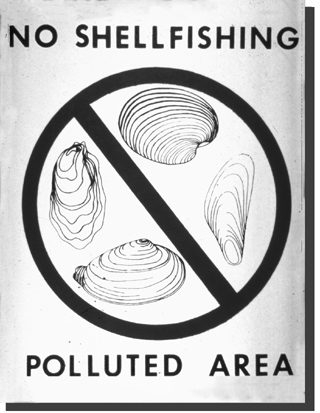 A Multi-User
Disposal Site (MUDS) located in or near the Sound would greatly increase
the region's ability to maintain harbors, clean up contaminated sediments,
restore marine habitat and allow for the development of waterfront property.
After reviewing public comment on the EIS, the agencies who are party
to the study will select one or more preferred alternatives for disposal
and will then likely prepare a site-specific EIS and feasibility report
for each one.
A Multi-User
Disposal Site (MUDS) located in or near the Sound would greatly increase
the region's ability to maintain harbors, clean up contaminated sediments,
restore marine habitat and allow for the development of waterfront property.
After reviewing public comment on the EIS, the agencies who are party
to the study will select one or more preferred alternatives for disposal
and will then likely prepare a site-specific EIS and feasibility report
for each one.
This Study is a three-year, $3.5 million planning effort which is being
funded by the Corps and the State of Washington, as part of the Cooperative
Sediment Management Program. The Corps, the Washington Departments of
Ecology and Natural Resources, the Puget Sound Water Quality Action Team,
USEPA and the Washington Public Ports Association are all part of this
planning effort. For more information, contact John Malek at (206) 553-1286.
| EPA
Laboratories |
Gut Purging Times in Bioaccumulation Tests Re-Evaluated
USEPA and ASTM protocols for 28-day bioaccumulation testing with the freshwater oligochaete, Lumbriculus variegatus, suggest holding animals in clean water prior to analysis to allow the organisms to clear sediment from their gut. The purpose of this purging period is to prevent sediment-associated chemicals from being measured as part of the whole-body residue. Previous USEPA guidance was for a 24-hour purging period, though some have raised concerns that purging for this long may allow organisms to depurate chemical from their tissues, thus reducing their apparent body burden.
Results of Re-evaluation
Researchers at the Mid-continent Ecology Division (MED)-Duluth re-evaluated
this guidance based on measured rates of sediment elimination and modeled
depuration of chemical from tissues. Results of this analysis indicate
that >98 percent of sediment in the gut is eliminated within 6 hours of
purging. Rates of chemical depuration are dependent on octanol/water partition
coefficient ![]() .
For chemicals with log
.
For chemicals with log ![]() > 5, Lumbriculus should retain >90 percent of their tissue burden after
the full 24 hours of purging originally recommended. If the purging period
is shortened to 6 hours, chemicals with log
> 5, Lumbriculus should retain >90 percent of their tissue burden after
the full 24 hours of purging originally recommended. If the purging period
is shortened to 6 hours, chemicals with log ![]() as low as 4 should remain at >90 percent of the original tissue burden,
with no appreciable influence of sediment in the gut. So, for most applications,
purging periods of 6 or 24 hours are suitable if the chemicals of interest
have log
as low as 4 should remain at >90 percent of the original tissue burden,
with no appreciable influence of sediment in the gut. So, for most applications,
purging periods of 6 or 24 hours are suitable if the chemicals of interest
have log ![]() >
5, but the 6-hour purging period should be used for analytes with log
>
5, but the 6-hour purging period should be used for analytes with log
![]() between 4
and 5.
between 4
and 5.
For More Information
Guidance on this topic has been revised for the new edition of the EPA freshwater sediment test guidance due out in early summer. The information will also appear in Environmental Toxicology and Chemistry in June 1999. For more information, contact Dave Mount, EPA, MED-Duluth, at (218) 529-5169.
EPA Compares Toxicity Using Hyallela and Fathead Minnows
The sediment toxicity test methods discussed in this article, 7-day Hyalella azteca and fathead minnow toxicity tests, are not standard EPA methods. However, they are being developed and evaluated by the Office of Research and Development’s National Exposure Research Laboratory (ORD ERL) in Cincinnati, Ohio.
Summary
Since 1992, seventy-three sediment samples have been tested side-by-side using a 7-day Hyallela azteca (HA) survival method and a 7-day fathead minnow embryo-larval (e/l) survival/terata test. In 1992 and 1993, 10 reference toxicant tests were also conducted. Of the 73 tests run, 28 (38 percent) of the sediments were found to be toxic (survival < 70 percent) using the e/l method but not toxic using the HA method. Eighteen of the samples were found to be toxic using both methods; of the 18, 9 showed more toxicity in the e/l test than the HA test and 3 were more toxic in the HA test than the e/l test. Ten tests (13%) showed toxicity in the HA test but not the e/l test (9 of these were in organic contaminated sediments) and 7 sediments were not toxic to either the e/l or HA methods.
Additional tests are being conducted on samples collected in the Environmental Monitoring and Assessment Program (EMAP), where both the 7-day and 10-day HA methods will be run side-by-side with the e/l method. Samples collected in the EMAP program will have been chosen randomly and have different types of contaminants in them. Previous testing using the HA method has shown that less than 5 percent of the samples collected across the mid-Atlantic region are toxic to Hyallela azteca.
Additional Tests
Additional tests will be performed in FY 1999 on EMAP sediments (acute Hyallela tests), sediments from NRMRL Attenuated/Restoration Sediments Study (acute Hyallela and Lumbriculus tests; bioaccumulation tests using Lumbriculus), and other sediments from regional offices. A whole sediment reference toxicant method will be developed in 1999 as well. A draft manuscript will be prepared in 1999 if results continue to indicate that the method is as sensitive as the existing HA method.
Procedures for EIS Method
Below are the steps that are involved in the fathead minnow embryo-larval toxicity testing method.
For More Information
To obtain more in-depth information on the standard operating procedures for this method contact Dr. Jim Lazorchak at (513) 569-7076, USEPA Facilities, 26 West MLK Dr./642, Cincinnati, OH 45268.
| Announcements
|
OW Requests Science Advisory Board Review of Integrated Approach to Metals Toxicity Assessment
The Office of Water has requested a Science Advisory Board (SAB) Review of its Integrated Approach to Assessing the Bioavailability and Toxicity of Metals in Surface Waters and Sediments at an early April meeting. This integrated approach represents the culmination of several years of OW and ORD efforts to more accurately predict metals bioavailability and toxicity in both the water column and sediments.
Toxicity in the Water Column
In the water column, the approach includes a Biotic Ligand Model (BLM) that quantifies the capacity of metals to bind to the gills of aquatic organisms. This model can be used to calculate the bioavailable portion of dissolved metals in the water column based on site-specific water quality parameters such as alkalinity, pH and dissolved organic carbon. By the end of 1999, OW plans to make the BLM available to users as an alternative to the current Water Effect Ratio (WER) methodologies. In the longer term, OW intends to incorporate the BLM directly into aquatic life criteria documents.
Toxicity in Sediments
In sediments, the approach includes guidance described in the document, Metals Mixtures Equilibrium Partitioning Sediment Guidelines (ESG). This document is currently being revised in preparation for the SAB Review (see previous article “Status on Sediment Guidelines Documents” for more details).
For More Information
The SAB was asked to review the scientific validity of the integrated approach and determine whether it improves the ability to assess and protect aquatic and benthic biota from metals toxicity. More information on the technical charge to the SAB, as well as SAB comments on the approach, will be included in future newsletters.
For more information, contact Jennifer Mitchell (202) 260-6101 (e-mail: mitchell.jennifer@epa.gov); Heidi Bell (202) 260-5464 (e-mail: bell.heidi@epa.gov); or Mary Reiley (202) 260-9456 (e-mail: reiley.mary@epa.gov).
EPA Releases New Inventory of Watershed Training Courses
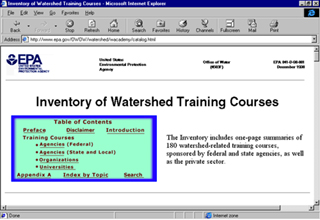 Are you
interested in taking a watershed-related training course in 1999? If so,
you will want to look at EPA’s recently published Inventory of Watershed
Training Courses. This Inventory provides one-page summaries of 180
watershed-related training courses sponsored by Federal and state agencies,
as well as the private sector. The course summaries provide you with enough
information to determine your level of interest and contacts for further
information—much like a college catalogue. The Inventory was developed
in response to a key action item listed in the Clean
Water Action Plan that says “In 1998, federal agencies will complete
an inventory of watershed training programs. Relevant offerings will be
promoted through the Watershed Academy and through other means as appropriate.”
The Inventory was developed with the assistance and support of several
interagency training workgroups, an EPA training workgroup, the private
sector and others.
Are you
interested in taking a watershed-related training course in 1999? If so,
you will want to look at EPA’s recently published Inventory of Watershed
Training Courses. This Inventory provides one-page summaries of 180
watershed-related training courses sponsored by Federal and state agencies,
as well as the private sector. The course summaries provide you with enough
information to determine your level of interest and contacts for further
information—much like a college catalogue. The Inventory was developed
in response to a key action item listed in the Clean
Water Action Plan that says “In 1998, federal agencies will complete
an inventory of watershed training programs. Relevant offerings will be
promoted through the Watershed Academy and through other means as appropriate.”
The Inventory was developed with the assistance and support of several
interagency training workgroups, an EPA training workgroup, the private
sector and others.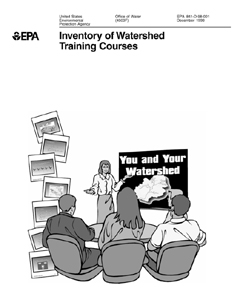
To Obtain a Copy
Copies of the Inventory of Watershed Training Courses are available at no charge from NCEPI at 800-490-9198 (please include the document number in requests: EPA 841-D-98-001). The Inventory is also available on the Watershed Academy website at: http://www.epa.gov/OWOW/watershed/wacademy/catalog.html.
EPA OST Announces the Availability of a Video
EPA has produced a video, TMDLs and Water Quality Standards, that is now available and provides information on Total Maximum Daily Loads (TMDLs) and the role TMDLs play in implementing State/Tribal water quality standards. Water quality standards are the cornerstone of State/Tribal water quality management programs. TMDLs and the TMDL development process are integral parts of State/Tribal water quality management programs. The relationship between TMDLs and water quality standards covers a wide area and includes such things as how TMDLs are authorized, their importance in the water quality-based approach to pollution control and how they are developed. The video also discusses the important role played by States, Tribes, EPA, and the public in the development of TMDLs.
The 22-minute video can be obtained on loan for a period of 30 days from: USEPA, Water Resource Center, 401 M St., SW (Mail Code RC4100), Washington, DC 20460; (202) 260-7786.
As part of the public domain, the video may be duplicated. The EPA order number is: EPA-823-V-00-001.
| Contaminated Sediment Webpages |
 Interested in
checking out some contaminated-sediment websites? Here are a few you can
browse:
Interested in
checking out some contaminated-sediment websites? Here are a few you can
browse:
• Region 5 site that highlights the Great Lakes National Program Office and existing Great Lakes documents. http://www.epa.gov/glnpo/arcs/
• Contaminated-Sediment Database: A tool for research and management in Massachusetts Waters (1994 GSA). USGS in collaboration with other agencies compiled a database of data collected on contamination in the sediments of Boston Harbor. http://woodshole.er.usgs.gov/epubs/abstracts/msg00053.html
• SEDTEC-Contaminated Sediment Removal and Treatment Technologies Directory (Environment Canada). SEDTEC is a user-friendly computer directory of technologies for removal and treatment of contaminated sediments. http://www.cbsc.org/ontario/bis/1997.html
• In-Situ Capping of Contaminated Sediments. This website is an introduction to in-situ capping. http://leoeml.gtri.gatech.edu/home/markh/capping/
• Los Angeles Basin Contaminated Sediments Task Force. In October 1997
legislation was passed that required the establishment of a multi-agency
Contaminated Sediment Task Force (Task Force). The Task Force objective
is to prepare a long-term management plan for dredging and disposal of
contaminated sediment in the Los Angeles area. http://ceres.ca.gov/coastalcomm/web/sediment/sdindex.html ![]()
• Manistique River, Lake Michigan. This site discusses the Manistique
River, its contamination, and actions being taken to restore the river.
http://www.lkmichiganforum.org/ ![]()
If you would like to share a website with the readers of CSNews, send your website address and description to Jane Farris, EPA, at farris.jane@epa.gov.
Creature Feature
I always keep the light on and especially enjoy pea crabs
and gobies for guests.
Local calls are free.
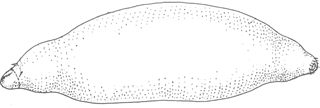
![]()
CSN
Activities Timeline  |
June 6-9, 1999
Keep America Growing Conference: Balancing Working Lands and Development, Philadelphia, PA. This conference will feature more than 150 presentations on issues such as land use and population trends, the impact of unplanned growth, successful programs that balance development and land use, and the urban-rural connection. Contact Cindy Delaney at (802) 655-7769; e-mail: delaney@together.net
June 6-10, 1999
ASCE’s Water Resources Planning and Management Division Conference. The Task Committee on Evaluation of Best Management Practices will present a special set of papers on BMP’s. Contact england@mindspring.com.
June 9-11, 1999
Third Annual Statewide Pollution Prevention Conference, in Jacksonville, FL. Contact: Dawn Jenkins, University of Florida, TREEO Center, 3900 SW 63rd Blvd., Gainesville, FL 32608-3800, phone: 352-392-9570; fax: 352-392-6910; e-mail: djenkin@treeo.doce.flu.edu
June 9-12, 1999
Third National Workshop on Constructed Wetlands: BMPs For Nutrient Reduction and Coastal Water Protection, in New Orleans, LA. Contact: Dr. Frank Humenik, 919-515-6767; frank_humenik@ncsu.edu.
June 16-18, 1999
Virginia’s Sustainable Future, Richmond, VA. To register, call
(804) 360-1500; e-mail: malloymsm@aol.com;
web site: www.deq.state.va.us. ![]()
July 11-14, 1999
The Sixth Symposium on Biogeochemistry of Wetlands, Ft. Lauderdale,
FL. Contact the University of Florida, IFAS Office of Conferences by phone
352-392-5930 or fax 352-392-9734, or by e-mail: mrp@gnv.ifas.ufl.edu
or visit the University of Florida’s web site at gnv.ifas.ufl.edu/~conferweb/#upcoming.![]()
July 14-17, 1999
Sixth Biennial Stormwater Research and Watershed Management Conference, Tampa, FL. Contact Diane Caban, Mail Code: MAN, SWFWMD, 2379 Broad Street, Brooksville, FL 34609-6899. Phone: (352) 796-7211
July 24-30, 1999
Coastal Zone ‘99, San Diego, CA. Contact: Urban Harbors Institute, University of Massachusetts, Boston 100 Morrissey Blvd., Boston, MA 02125-3393.
July 26-30, 1999
U.S. Environmental Protection Agency Water Quality Standards Academy - Basic Course, in Arlington, VA. Contact: Water Quality Standards Academy Coordinator at The Cadmus Group, Inc., 703-998-6862, ext. 190.
August 8-11, 1999
Walk on the Wild Side, Soil and Water Conservation Society Annual Conference, Biloxi, Mississippi. Contact: Pat Mulligan 515-298-2331, ext. 17; e-mail: conf@asce.org.
August 9-12, 1999
1999 Stockholm Water Symposium: Urban Stability Through Integrated
Water-Related Management, Stockholm, Sweden. Contact the Stockholm
International Water Institute at +46 -8-736-20-08; e-mail: sympos@siwi.org;
web site: http://www.siwi.org/. ![]()
August 16-20, 1999
Working at a Watershed Level, Durham, NH. Course addresses watershed
ecology, system dynamics, assessment and analysis, planning/management
approaches, remediation strategies, public involvement, and outreach/education.
Contact Barry Tonning at (606) 244-8228; e-mail: btonning@csg.org;
web site: http://www.statesnews.org/ecos/working.htm. ![]()
August 31 - September 1, 1999
EPA Regional Beach Conference, in San Diego, CA. Contact: Rick Hoffmann, 202-260-0642.
EPA Standards and Applied Science Division has developed a list-server (electronic mailing list service) called WQS-NEWS. As a subscriber to the list-server, you can receive electronic copies of various Division publications including newsletters (Water Quality Standards and Contaminated Sediment News) and other announcements and information about upcoming meetings and programs. Subscribers must have an e-mail address.
To subscribe to WQS-NEWS, please send a special e-mail message to listserver@unixmail.rtpnc.epa.gov. Leave the message’s subject header blank and provide the following text in the body of the message: Subscribe WQS-NEWS Firstname Lastname. (e.g., Subscribe WQS-NEWS Joan Doe.).
To stop receiving CSNews electronically, type “Unsubscribe WQS-NEWS” in the body of the message. You do not need to include your first and last name.
To change your mailing address, you may send the following information to Jane Marshall Farris (farris.jane@epamail.epa.gov).
Note: Those who have requested CSNews as a hard copy will continue to receive it in the mail. CSNews will also continue to be displayed on the Internet at http:www.epa.gov/waterscience/pc/csnews/.
|
Wastewater Management | Drinking Water | Wetlands, Oceans, and Watersheds |
||
|
|
||
|
|